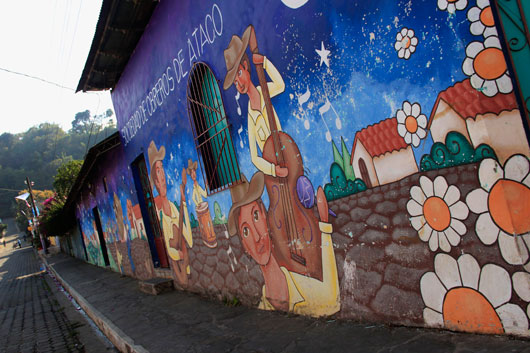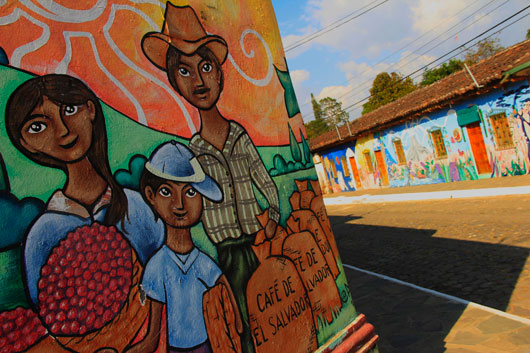Travel on public transportation, especially buses, both within and outside the capital, is risky and not recommended.
The US State Department certainly has a way with words. That quote nestled snugly into my brain while I walked to the bus station, and played like subtitles across the bottom of the screen as I watched people watching me.

But bus #205 from San Salvador to Sonsonate was every bit as harmless and comfortable as the buses to and from Playa Tunco, the second of which felt so safe that I fell asleep on it, necessitating the third bus of the day after I dozed past my stop. In the end, I felt I’d gotten a tour of the city for $0.60. The Sonsonate bus station, sheet metal platform ceiling high above the slanted slots where buses picked up passengers, felt identical to dozens of terminals I’ve passed through around the world. These queues could have been for Montezuma, Malaga, or Marrakech.
El Salvador has the same “chicken buses” that are famous in Guatemala. Former US school buses, they bear little resemblance to the cookiecutter canary canisters of my childhood, instead painted with the sort of chromatic audacity that makes me pine for Latin America whenever I’m in Europe.
My bus #249 from Sonsonate to Ataco was vermillion and fuchsia with lime-green accents, burgundy tassels lined the windshield, and a melange of religious icons and commercial logos was splattered around the edges. I barely noticed the colors in the bus though, my eyes drawn instead to what was outside as we ascended La Ruta de las Flores.
La Ruta was the most common answer when I asked people where I should go in El Salvador, and I’ll translate the name as The Path of Flowers, since “route” is not nearly romantic enough for this series of five small mountain towns. When we pulled into the first town, Nahuisalco, however, I’ll admit I wasn’t dazzled by the place. It seemed like a nice town, real and clean in an appealing way after the smog and hustle of the capital, but I wasn’t sure what I would DO there, exactly. Apparently the town is famous for its handmade furniture. I applaud that in principle, but I was hardly in the market for a dining room table.
The next town we stopped in was Apaneca, where a billboard (complete with grinning gringo in a yellow helmet) proclaimed this the home of a zip-line course. Now you’re talking. The colorful buildings appealed to my eyes and the stone-paved streets called to my feet, and I resolved to return to Apaneca.

My destination was the next town though, Ataco, where a delegate friend had assured me I would find a good place to stay and things worth looking at. As soon as I stepped off the bus, I knew he was right. Rich murals covered many of the walls, while others chipped away to reveal adobe bricks spiky with straw. On a quiet side street I found Hostal Cipres, with its tangerine and lime sherbet sofas, mountainous bougainvillea, and rhythmic tapping as they added three more rooms to complement the three they already have.
La Ruta has been around for a while, and is inevitably growing. I didn’t see any other tourists while I was there, but it’s only a matter of time, so go now.
I hadn’t known what to expect from accommodation in El Salvador, and memories of the funk I’ve found elsewhere in the region had me facing the search with a certain amount of resolve, but Hostal Cipress was spotless, nary a bug nor dustbunny to be found, while the staff were friendly, helpful, and welcoming. Wifi, coffee, and cable. I had the room with two double-beds to myself, private bathroom with warm water, for $20 a night.

There’s something to enjoy about almost everywhere, but I have a short-list of places I’ve loved from the start. San Cristobal de las Casas, Istanbul, Riga…and now Ataco. There was something in the temperature, the flavor of the pupusas, or the gait of the old woman walking to the market.
I had been concerned that two and a half days would be too long in that area, that I’d get bored. Now I knew I loved Ataco, and was eager to return to Apaneca. Luckily for me, I hadn’t heard about the two nearby crater lakes, the renowned food market of Juayua, or the waterfalls just south of town.
If I’d known all that, I don’t think I would have been able to leave. As it is? I want to go back.
Read Ethical Traveler's Reprint Policy.
